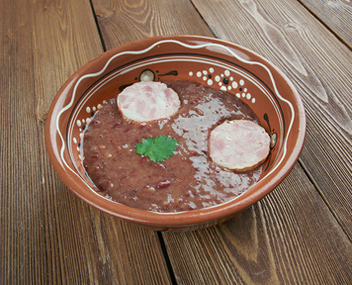How much to cook shiruko soup?
 Cook Shiruko for 2 hours.
Cook Shiruko for 2 hours.
How to make shiruko soup
Soup products
Red adzuki beans - 200 grams
Polished rice - 3/4 cup
Soup water - 1.5 liters
Sugar - 250 grams
Salt - 1/2 teaspoon
Preparing adzuki and rice
1. Pour 200 grams of well-washed adzuki into a deep bowl and pour in 2 glasses of cool, clean water.
2. Soak for 8 hours or overnight.
3. Rinse 3/4 cup of rice, add clean water overnight (1 cup). Drain off used water.
4. Put the soaked rice in a saucepan, add 1 glass of fresh water, a pinch of salt.
4. Put on low heat, cook, slightly sliding the lid, until the liquid disappears.
How to make shiruko soup
1. Drain the adzuki water, put the beans in a deep saucepan, add fresh water (covering the beans completely), boil.
2. Rinse the beans in a colander with cool running water.
3. Return the beans to the pot, add fresh water again, boil, add 2 cups of cool water.
4. Cook the beans over low heat for 60 minutes, opening the lid and removing the foam that comes up with a spoon or fine strainer.
5. Top up with boiled water if the liquid in the pot evaporates quickly.
6. Remove the pan from the heat when the adzuki becomes soft (to check this, you need to pierce the beans with a fork), cool slightly.
7. Grind boiled adzuki into a homogeneous paste (with a pestle or blender), add 250 grams of sugar and 1/2 teaspoon of salt to the paste, mix well.
8. Pour a small amount of boiling water into the adzuki paste and stir - the result should be a creamy consistency.
9. Crush boiled rice with a pestle or grind with a blender, periodically moistening the rice mass with water (the mass should become slightly sticky).
10. Form into balls or small cakes.
11. Place mochi cakes in bowls and add shiruko soup.
Fusofacts
- The Japanese respectfully call this soup "o-shiruko" - the use of the respectful prefix emphasizes the important place of shiruko in national cuisine.- Another Japanese variety of shiruko soup - not made from pasta, but from whole beans - is called zenzai. In China, a similar dish is named hundousha - it is served hot in winter and chilled in summer, in the heat it is used to make ice cream on a stick. In Korea, the analogue of shiruko is called phatchuk.
- According to the legend, phatchuk soup is able to protect them from any evil, especially from diseases: red symbolizes powerful positive energy. The nutritional value of the soup is also symbolic: it is a ritual dish that has been served since ancient times in order to harvest a rich harvest in the future.
- Azuki contains a lot of protein and is very useful: it contains vitamin E (supports the health of the skin, blood vessels, metabolism) and B6 (strengthens the immune and nervous system), phosphorus (regulates the functioning of the brain, is good for muscles), magnesium (gives energy , eliminates toxins), calcium (ensures metabolic processes, health of the bone and cardiovascular system), fiber (stabilizes digestion).
Soaking red beans before cooking not only makes them softer and tastier. Soaking the adzuki is necessary for better absorption: water dissolves the bitter substance tannin and other components that lead to indigestion.
- Mochi - popular in Japan, glutinous rice cakes, a bit like dumplings. They are eaten all year round, but especially on New Year's Eve: mochi are believed to bring good luck. In Japan, hot shiruko soup with rice cakes is usually served in winter as a warming dish. In a more satisfying version, shiruko is served with sliced sausage.
- Look more soupshow to cook them and cooking time!
Last update Author / Editor - Lydia Ivanova




